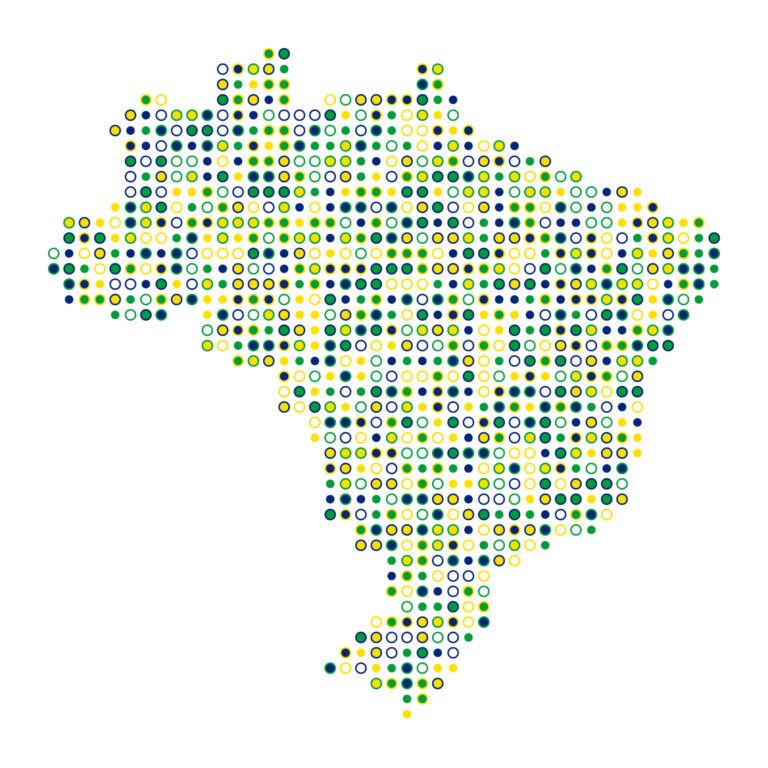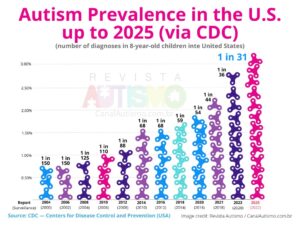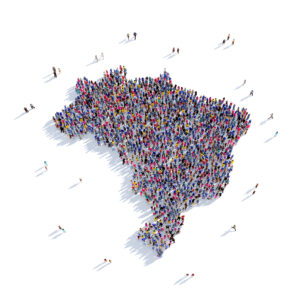Tempo de Leitura: 3 minutos
By Francisco Paiva Jr.,
editor-in-chief of
Revista Autismo magazine (Brazil)
>>Versão em português 🇧🇷
Brazil has officially released its first national statistics on autism diagnoses. According to preliminary data from the 2022 Census, published today (May 23, 2025) by the Brazilian Institute of Geography and Statistics (IBGE, in Portuguese), 2.4 million people across the country reported having received a diagnosis of autism spectrum disorder (ASD) from a healthcare professional. That figure represents 1.2% of the Brazilian population aged two and older.
As seen in other countries, autism diagnoses in Brazil are more prevalent among males (1.5%) than females (0.9%) — a ratio of about 1.4 males for every female. However, the most striking figure comes from a younger cohort: 2.6% of Brazilian children aged 5 to 9 — or 1 in every 38 — have received an ASD diagnosis. Among boys in this age group, the rate climbs to 3.8% (264,000), compared to 1.3% (86,000) for girls — a ratio of 3.1 to 1.
Dr. Rosa Magaly Moraes, a child and adolescent psychiatrist at the University of Sao Paulo’s Hospital das Clinicas (HC-FMUSP), sees this as a turning point. “Having official numbers brings Brazil in line with countries like the United States, South Korea, and Australia, where prevalence estimates now fall within a similar range,” she told Revista Autismo, a leading autism-focused publication in Brazil.
It’s important to note that this data is based on self-reporting — no medical documentation was required. Census takers asked whether anyone in the household had received an autism diagnosis from a health professional. As a result, undiagnosed individuals are not reflected in the data, and the actual number of autistic people in Brazil is likely much higher.
One strong indicator comes from the 5–9 age group: based on the 2.6% diagnosis rate applied to the national population (212.6 million as of July 2024), Brazil could have over 5.5 million autistic individuals — far more than the 2.4 million reported. This estimate does not include late-diagnosed adults, who remain largely unaccounted for.
“These figures provide a solid foundation for public policy and research,” said Dr. Moraes. “They help us understand subgroups by gender, age, and other demographics — and guide more targeted interventions grounded in community and public health.”
Dr. Moraes also emphasized enduring barriers: “The greatest challenge in Brazil is still the lack of awareness and training — many health and education professionals are not sufficiently prepared to recognize ASD, especially among underrepresented populations such as very young children, girls, gifted individuals, or older adults.”
Comparing with U.S. data
The Brazilian findings are broadly consistent with recent prevalence data from the U.S. Centers for Disease Control and Prevention (CDC), released on April 17, 2025. The CDC reported that 1 in 31 8-year-olds in the U.S. are on the autism spectrum, reflecting a 3.2% prevalence rate. While slightly higher than Brazil’s numbers, the trend lines are similar.
Gender ratios are comparable as well: the CDC reports a 3.4-to-1 male-to-female ratio among diagnosed 8-year-olds, while Brazil’s data for ages 5–9 shows a near-identical 3.1-to-1 ratio.
Educational and racial disparities
Nearly half (46.1%) of those diagnosed with ASD in Brazil have no formal education or only incomplete primary education — highlighting longstanding obstacles to educational inclusion. Yet the school enrollment rate among autistic individuals aged 6 and older (36.9%) surpasses that of the general population (24.3%), suggesting expanded access in more recent generations.
When viewed by race, white Brazilians (1.3%) reported higher rates of autism diagnosis than Black (1.1%) or Indigenous (0.9%) individuals — a disparity mirroring trends observed in past U.S. research. “There’s no evidence that Black or mixed-race Brazilians are less likely to be autistic,” Dr. Moraes noted. “More likely, these differences reflect unequal access to healthcare.”
Inclusion in schools and national planning
According to the IBGE, 508,000 autistic students are enrolled in mainstream elementary education, while 760,800 students aged 6 and older have an ASD diagnosis. These numbers are expected to influence policymaking in education, healthcare, and social inclusion.
The census also collected data on disability in general: 14.4 million Brazilians — 7.3% of the population — reported some form of disability, with prevalence rising sharply in older age groups. Among those with disabilities, just 7.4% had completed higher education, and 21.3% were illiterate.
Autism in Brazil’s Census
Autism was included in the 2022 Census after a sustained grassroots campaign by autistic self-advocates and families — backed by Brazilian TV personality and autism parent Marcos Mion. Their efforts led to Law No. 13.861, signed in July 2019, which mandated the inclusion of a question on autism in the Census.
The question appeared in the Census sample form, administered to 11% of households, and was phrased as follows:
“Has this person ever been diagnosed with autism by a health professional?”
While not comprehensive, the data marks the first time Brazil has quantified autism diagnoses at the national level. It’s a significant milestone — and a foundation for future action.
For access to the full report (in Portuguese), visit this link.
 Francisco Paiva Jr.
Francisco Paiva Jr.



